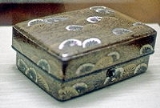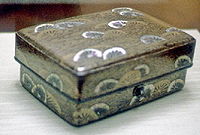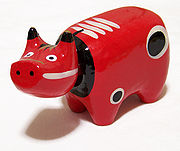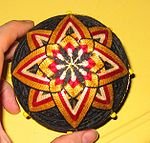
Japanese handicrafts
Encyclopedia
The many and varied traditional handicraft
s of Japan
are officially recognised and protected and, owing to the folk art movement
, are much in demand. Some enjoy status as a meibutsu
or regional specialty. Each craft demands a set of specialized skills. Textile
crafts, for example, include silk
, hemp
, and cotton
, woven (after spinning and dyeing) in forms from timeless folk designs to complex court patterns. Village crafts evolving from ancient folk traditions also continued in weaving
and indigo
dyeing in Hokkaidō
by the Ainu people
s, whose distinctive designs had prehistoric prototypes, and by other remote farming families in northern Japan.
weaving center of Kyoto
, where elegant fabrics worn by the emperor and the aristocracy
were produced. In the 17th century, designs on textiles were applied using stencils and rice paste, in the yuzen or paste-resist method of dyeing. The yuzen method provided an imitation of aristocratic brocade
s, which were forbidden to commoners by sumptuary laws.
Moriguchi Kako of Kyoto has continued to create works of art in his yuzen-dyed kimono
s, which were so sought after that the contemporary fashion industry designed an industrial method to copy them for use on Western-style clothing. Famous designers, such as Hanae Mori
, borrowed extensively from kimono patterns for their couturier collections. By the late 1980s, an elegant, handwoven, dyed kimono had become extremely costly, running to US$25,000 for a formal garment. In Okinawa the famous yuzen-dyeing method was especially effective where it was produced in the bingata
stencil-dyeing techniques, which produced exquisitely colored, striking designs as artistic national treasures.
Other methods of resist dyeing
are Rōketsuzome
with wax, Katazome
and Tsutsugaki
with rice-paste.
 Lacquer
Lacquer
was invented in Asia, and its use in Japan can be traced to prehistoric finds. Lacquer ware is most often made from wooden objects, which receive multiple layers of refined lac juices, each of which must dry before the next is applied. These layers make a tough skin impervious to water damage and to resist breakage, providing lightweight, easy-to-clean utensils of every sort. The decoration on such lacquers, whether carved through different colored layers or in surface designs, applied with gold or inlaid with precious substances, has been a prized art form since the Nara period
(A.D. 710-94). (See also Lacquerware
.)
making is another contribution of Asian civilization; the Japanese art
of making paper from the mulberry
plant (called "Washi
") is thought to have begun in the 6th century A.D. Dyeing paper with a wide variety of hues and decorating it with designs became a major preoccupation of the Heian
court, and the enjoyment of beautiful paper and its use has continued thereafter, with some modern adaptations. The traditionally made paper called Izumo
(after the shrine area where it is made) was especially desired for fusuma
(sliding panels) decoration, artists' papers, and elegant letter paper. Some printmakers have their own logo made into their papers, and since the Meiji period
, another special application has been Western marbleized
end papers (made by the Atelier Miura in Tokyo
).

, of extremely high quality. These swords originated before the 1st century B.C. and reached their height of popularity as the chief possession of warlords and samurai
. The production of a sword has retained something of the religious quality it once had in embodying the soul of the samurai and the martial spirit of Japan. For many Japanese, the sword, one of the "three jewels
" of the nation, remained a potent symbol; possessors would treasure a sword and it would be maintained within the family, its loss signifying their ruin.
. Temari means "hand ball" in Japanese. Japanese Temari is a folk craft born in ancient Japan from the desire to amuse and entertain children with a toy hand ball.
 Today, the lovely thread-wrapped temari balls are given as tokens of good luck and they are displayed and enjoyed as works of art. As Buddhist missionaries traveled east from India through China via the Korea
Today, the lovely thread-wrapped temari balls are given as tokens of good luck and they are displayed and enjoyed as works of art. As Buddhist missionaries traveled east from India through China via the Korea
n peninsula to Japan, they spread not only religious beliefs but their culture as well. Temari is said to have its origins from Kemari
(football), brought to Japan from China about 1400 years ago. Making temari grew as a pastime for noble women in the early part of the Edo Period (1600–1868). Maids of the court made temari balls for princesses. They would sit on the floor with the children, rolling a temari between them. Bouncing and tossing games followed. Over the years, region by region, the women of Japan explored the craft and improved it. They added noisemakers to the inside to delight the ear. They added Japanese designs and copied the colors of nature around them, and they used the brilliant colors of kimono silk to stitch eye-catching patterns.
is the art of knitting or crocheting small stuffed animals and anthropomorphic creatures. Amigurumi are typically cute animals (such as bears, rabbits, cats, dogs, etc.), but can include inanimate objects endowed with anthropomorphic features. Amigurumi can be either knitted or crocheted. In recent years crocheted amigurumi are more popular and more commonly seen.
or hair ornaments are artifical flowers made from silk. They are worn by geisha
and apprentices
.
Handicraft
Handicraft, more precisely expressed as artisanic handicraft, sometimes also called artisanry, is a type of work where useful and decorative devices are made completely by hand or by using only simple tools. It is a traditional main sector of craft. Usually the term is applied to traditional means...
s of Japan
Japan
Japan is an island nation in East Asia. Located in the Pacific Ocean, it lies to the east of the Sea of Japan, China, North Korea, South Korea and Russia, stretching from the Sea of Okhotsk in the north to the East China Sea and Taiwan in the south...
are officially recognised and protected and, owing to the folk art movement
Folk art
Folk art encompasses art produced from an indigenous culture or by peasants or other laboring tradespeople. In contrast to fine art, folk art is primarily utilitarian and decorative rather than purely aesthetic....
, are much in demand. Some enjoy status as a meibutsu
Meibutsu
Meibutsu is a Japanese term for famous products associated with particular regions. Meibutsu are usually items of Japanese regional cuisine, although the category includes local handicrafts. Meibutsu typically have a traditional character, although contemporary products may qualify as meibutsu...
or regional specialty. Each craft demands a set of specialized skills. Textile
Textile
A textile or cloth is a flexible woven material consisting of a network of natural or artificial fibres often referred to as thread or yarn. Yarn is produced by spinning raw fibres of wool, flax, cotton, or other material to produce long strands...
crafts, for example, include silk
Silk
Silk is a natural protein fiber, some forms of which can be woven into textiles. The best-known type of silk is obtained from the cocoons of the larvae of the mulberry silkworm Bombyx mori reared in captivity...
, hemp
Hemp
Hemp is mostly used as a name for low tetrahydrocannabinol strains of the plant Cannabis sativa, of fiber and/or oilseed varieties. In modern times, hemp has been used for industrial purposes including paper, textiles, biodegradable plastics, construction, health food and fuel with modest...
, and cotton
Cotton
Cotton is a soft, fluffy staple fiber that grows in a boll, or protective capsule, around the seeds of cotton plants of the genus Gossypium. The fiber is almost pure cellulose. The botanical purpose of cotton fiber is to aid in seed dispersal....
, woven (after spinning and dyeing) in forms from timeless folk designs to complex court patterns. Village crafts evolving from ancient folk traditions also continued in weaving
Weaving
Weaving is a method of fabric production in which two distinct sets of yarns or threads are interlaced at right angles to form a fabric or cloth. The other methods are knitting, lace making and felting. The longitudinal threads are called the warp and the lateral threads are the weft or filling...
and indigo
Indigo
Indigo is a color named after the purple dye derived from the plant Indigofera tinctoria and related species. The color is placed on the electromagnetic spectrum between about 420 and 450 nm in wavelength, placing it between blue and violet...
dyeing in Hokkaidō
Hokkaido
, formerly known as Ezo, Yezo, Yeso, or Yesso, is Japan's second largest island; it is also the largest and northernmost of Japan's 47 prefectural-level subdivisions. The Tsugaru Strait separates Hokkaido from Honshu, although the two islands are connected by the underwater railway Seikan Tunnel...
by the Ainu people
Ainu people
The , also called Aynu, Aino , and in historical texts Ezo , are indigenous people or groups in Japan and Russia. Historically they spoke the Ainu language and related varieties and lived in Hokkaidō, the Kuril Islands, and much of Sakhalin...
s, whose distinctive designs had prehistoric prototypes, and by other remote farming families in northern Japan.
Yuzen
Silk-weaving families can be traced to the 15th century in the famous NishijinNishijin
is a traditional textile produced in Kamigyō-ku, Kyoto, Japan.-History:Nishijin weaving was created in Kyoto over 1200 years ago by using many different types of colored yarns and weaving them together into decorative designs...
weaving center of Kyoto
Kyoto
is a city in the central part of the island of Honshū, Japan. It has a population close to 1.5 million. Formerly the imperial capital of Japan, it is now the capital of Kyoto Prefecture, as well as a major part of the Osaka-Kobe-Kyoto metropolitan area.-History:...
, where elegant fabrics worn by the emperor and the aristocracy
Kuge
The was a Japanese aristocratic class that dominated the Japanese imperial court in Kyoto until the rise of the Shogunate in the 12th century at which point it was eclipsed by the daimyo...
were produced. In the 17th century, designs on textiles were applied using stencils and rice paste, in the yuzen or paste-resist method of dyeing. The yuzen method provided an imitation of aristocratic brocade
Brocade
Brocade is a class of richly decorative shuttle-woven fabrics, often made in colored silks and with or without gold and silver threads. The name, related to the same root as the word "broccoli," comes from Italian broccato meaning "embossed cloth," originally past participle of the verb broccare...
s, which were forbidden to commoners by sumptuary laws.
Moriguchi Kako of Kyoto has continued to create works of art in his yuzen-dyed kimono
Kimono
The is a Japanese traditional garment worn by men, women and children. The word "kimono", which literally means a "thing to wear" , has come to denote these full-length robes...
s, which were so sought after that the contemporary fashion industry designed an industrial method to copy them for use on Western-style clothing. Famous designers, such as Hanae Mori
Hanae Mori
Hanae Mori is a fashion designer in Japan. She is the only Japanese woman to have presented her collections on the runways of Paris and New York, and the first Asian woman to be admitted as an official haute couture design house by the fédération française de la couture in France...
, borrowed extensively from kimono patterns for their couturier collections. By the late 1980s, an elegant, handwoven, dyed kimono had become extremely costly, running to US$25,000 for a formal garment. In Okinawa the famous yuzen-dyeing method was especially effective where it was produced in the bingata
Bingata
Bingata is an Okinawan traditional resist dyed cloth, made using stencils and other methods. It is generally bright-colored and features various patterns, usually depicting natural subjects such as fish, water, and flowers...
stencil-dyeing techniques, which produced exquisitely colored, striking designs as artistic national treasures.
Other methods of resist dyeing
Resist dyeing
Resist dyeing is a term for a number of traditional methods of dyeing textiles with patterns. Methods are used to "resist" or prevent the dye from reaching all the cloth, thereby creating a pattern and ground. The most common forms use wax, some type of paste, or a mechanical resist that...
are Rōketsuzome
Roketsuzome
Rōketsuzome or short rōzome is a traditional wax-resist textile dyeing technique in Japan, akin to Indonesian batik.- References :*...
with wax, Katazome
Katazome
Katazome is a Japanese method of dyeing fabrics using a resist paste applied through a stencil. With this kind of resist dyeing, a rice flour mixture is applied using a brush or a tool such as a palette knife. Pigment is added by hand-painting, immersion or both...
and Tsutsugaki
Tsutsugaki
Tsutsugaki The rice paste is typically made from sweet rice, which has a high starch content and is therefore rather sticky. The paste is applied through a tube similar to the tubes which are used by bakers to decorate cakes...
with rice-paste.
Lacquer

Lacquer
In a general sense, lacquer is a somewhat imprecise term for a clear or coloured varnish that dries by solvent evaporation and often a curing process as well that produces a hard, durable finish, in any sheen level from ultra matte to high gloss and that can be further polished as required...
was invented in Asia, and its use in Japan can be traced to prehistoric finds. Lacquer ware is most often made from wooden objects, which receive multiple layers of refined lac juices, each of which must dry before the next is applied. These layers make a tough skin impervious to water damage and to resist breakage, providing lightweight, easy-to-clean utensils of every sort. The decoration on such lacquers, whether carved through different colored layers or in surface designs, applied with gold or inlaid with precious substances, has been a prized art form since the Nara period
Nara period
The of the history of Japan covers the years from AD 710 to 794. Empress Gemmei established the capital of Heijō-kyō . Except for 5 years , when the capital was briefly moved again, it remained the capital of Japanese civilization until Emperor Kammu established a new capital, Nagaoka-kyō, in 784...
(A.D. 710-94). (See also Lacquerware
Lacquerware
Lacquerware are objects decoratively covered with lacquer. The lacquer is sometimes inlaid or carved. Lacquerware includes boxes, tableware, buttons and even coffins painted with lacquer in cultures mostly in the Eastern Hemisphere.-History:...
.)
Paper making
PaperPaper
Paper is a thin material mainly used for writing upon, printing upon, drawing or for packaging. It is produced by pressing together moist fibers, typically cellulose pulp derived from wood, rags or grasses, and drying them into flexible sheets....
making is another contribution of Asian civilization; the Japanese art
Japanese art
Japanese art covers a wide range of art styles and media, including ancient pottery, sculpture in wood and bronze, ink painting on silk and paper and more recently manga, cartoon, along with a myriad of other types of works of art...
of making paper from the mulberry
Mulberry
Morus is a genus of flowering plants in the family Moraceae. The 10–16 species of deciduous trees it contains are commonly known as Mulberries....
plant (called "Washi
Washi
is a type of paper made in Japan. Washi is commonly made using fibers from the bark of the gampi tree, the mitsumata shrub , or the paper mulberry, but also can be made using bamboo, hemp, rice, and wheat...
") is thought to have begun in the 6th century A.D. Dyeing paper with a wide variety of hues and decorating it with designs became a major preoccupation of the Heian
Heian period
The is the last division of classical Japanese history, running from 794 to 1185. The period is named after the capital city of Heian-kyō, or modern Kyōto. It is the period in Japanese history when Buddhism, Taoism and other Chinese influences were at their height...
court, and the enjoyment of beautiful paper and its use has continued thereafter, with some modern adaptations. The traditionally made paper called Izumo
Izumo
Izumo can refer to:* Izumo Province, one of the old provinces of Japan* Izumo, Shimane, a city in former Izumo province* Izumo-taisha, a famous Shinto shrine in Izumo city...
(after the shrine area where it is made) was especially desired for fusuma
Fusuma
In Japanese architecture, fusuma are vertical rectangular panels which can slide from side to side to redefine spaces within a room, or act as doors. They typically measure about wide by tall, the same size as a tatami mat, and are two or three centimeters thick...
(sliding panels) decoration, artists' papers, and elegant letter paper. Some printmakers have their own logo made into their papers, and since the Meiji period
Meiji period
The , also known as the Meiji era, is a Japanese era which extended from September 1868 through July 1912. This period represents the first half of the Empire of Japan.- Meiji Restoration and the emperor :...
, another special application has been Western marbleized
Paper marbling
Paper marbling is a method of aqueous surface design, which can produce patterns similar to smooth marble or other stone. The patterns are the result of color floated on either plain water or a viscous solution known as size, and then carefully transferred to an absorbent surface, such as paper or...
end papers (made by the Atelier Miura in Tokyo
Tokyo
, ; officially , is one of the 47 prefectures of Japan. Tokyo is the capital of Japan, the center of the Greater Tokyo Area, and the largest metropolitan area of Japan. It is the seat of the Japanese government and the Imperial Palace, and the home of the Japanese Imperial Family...
).

Metal work
Metalwork is epitomized in the production of the Japanese swordKatana
A Japanese sword, or , is one of the traditional bladed weapons of Japan. There are several types of Japanese swords, according to size, field of application and method of manufacture.-Description:...
, of extremely high quality. These swords originated before the 1st century B.C. and reached their height of popularity as the chief possession of warlords and samurai
Samurai
is the term for the military nobility of pre-industrial Japan. According to translator William Scott Wilson: "In Chinese, the character 侍 was originally a verb meaning to wait upon or accompany a person in the upper ranks of society, and this is also true of the original term in Japanese, saburau...
. The production of a sword has retained something of the religious quality it once had in embodying the soul of the samurai and the martial spirit of Japan. For many Japanese, the sword, one of the "three jewels
Imperial Regalia of Japan
The , also known as the Three Sacred Treasures of Japan, consist of the sword Kusanagi , the mirror Yata no Kagami , and the jewel Yasakani no Magatama...
" of the nation, remained a potent symbol; possessors would treasure a sword and it would be maintained within the family, its loss signifying their ruin.
Temari
There are many traditional handicrafts which involve fibre arts, one of them being the ancient craft of temariTemari (toy)
Temari balls are a folk art form that originated in China and was introduced to Japan five or six hundred years ago. "Temari" means "hand ball" in Japanese. Embroidered balls may be used in hand ball games.-History:...
. Temari means "hand ball" in Japanese. Japanese Temari is a folk craft born in ancient Japan from the desire to amuse and entertain children with a toy hand ball.

Korea
Korea ) is an East Asian geographic region that is currently divided into two separate sovereign states — North Korea and South Korea. Located on the Korean Peninsula, Korea is bordered by the People's Republic of China to the northwest, Russia to the northeast, and is separated from Japan to the...
n peninsula to Japan, they spread not only religious beliefs but their culture as well. Temari is said to have its origins from Kemari
Kemari
Kemari is a form of football that was popular in Japan during the Heian Period. Kemari has been revived in modern times.-History:The first evidence of kemari is from A.D.644. The rules were standardized from the 13th century. It was the first Japanese sport to become highly developed.The game was...
(football), brought to Japan from China about 1400 years ago. Making temari grew as a pastime for noble women in the early part of the Edo Period (1600–1868). Maids of the court made temari balls for princesses. They would sit on the floor with the children, rolling a temari between them. Bouncing and tossing games followed. Over the years, region by region, the women of Japan explored the craft and improved it. They added noisemakers to the inside to delight the ear. They added Japanese designs and copied the colors of nature around them, and they used the brilliant colors of kimono silk to stitch eye-catching patterns.
Amigurumi
AmigurumiAmigurumi
is the Japanese art of knitting or crocheting small stuffed animals and anthropomorphic creatures. The word is derived from a combination of the Japanese words ami, meaning crocheted or knitted, and nuigurumi, meaning stuffed doll...
is the art of knitting or crocheting small stuffed animals and anthropomorphic creatures. Amigurumi are typically cute animals (such as bears, rabbits, cats, dogs, etc.), but can include inanimate objects endowed with anthropomorphic features. Amigurumi can be either knitted or crocheted. In recent years crocheted amigurumi are more popular and more commonly seen.
Hair ornaments
Edo Tsumami KanzashiKanzashi
are hair ornaments used in traditional Japanese hairstyles. Some believe they may also have been used for defence in an emergency.In the English-speaking world, the term "kanzashi" is sometimes applied to the folded cloth flowers that traditionally adorned tsumami kanzashi, or to the technique used...
or hair ornaments are artifical flowers made from silk. They are worn by geisha
Geisha
, Geiko or Geigi are traditional, female Japanese entertainers whose skills include performing various Japanese arts such as classical music and dance.-Terms:...
and apprentices
Maiko (geiko)
is an apprentice geiko. Their jobs consist of performing songs, dances, and playing the shamisen for visitors at a feast...
.

